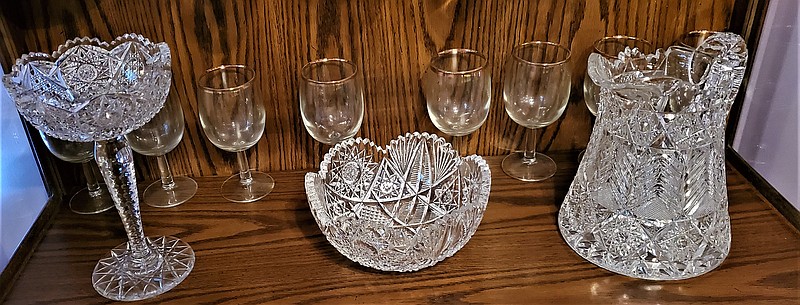DEAR HELAINE AND JOE: I would appreciate any information you can give me on these three pieces of glass. The family lore says my great-great-great grandfather brought them from Scotland in the 1790s. I am sure that is incorrect. I would like to know the true history and origins of these pieces.
Thank you, — S.W.D.
DEAR S.W.D.: You are right on the money with your feelings that your family lore is incorrect.
The pieces are certainly cut glass made in the United States, but there is no way that they were made in 1790, or anywhere near that date. It is absolutely true that American cut glass has been around for a very long time. But in the 18th and early 19th centuries, it was fairly simple with motifs such as panels, flutes and strawberry diamonds.
In the second half of the 19th century, things began to change. American glasshouses began faceting heavy, relatively thick, leaded glass blanks, and the Philadelphia Centennial Exposition of 1876 saw the flowering of American Brilliant Period cut glass.
The glass itself was generally handblown, and the designs on the surfaces were laboriously hand cut by artisans using a rotating copper wheel, sand and water. The polishing made the faceted pieces of glass sparkle like gemstones, and this too was also done by hand.
As the turn of the 20th century approached, this kind of cut glass was extremely labor-intensive and expensive, and it began being simplified to make it more cost-effective. The blanks got thinner, often of lesser quality, and the designs became more simplistic with motifs such as engraved flowers.
Sadly, by the beginning of World War I the American Brilliant Period of cut glass was over. During its heyday, however, it was one of the go-to gifts for men who had no idea what to give their wives for anniversaries, birthdays and other special occasions.
This sort of glassware was ubiquitous in china cabinets across America, and when company came, hosts poured water at the dinner table from cut glass pitchers, spooned berries from large cut glass bowls into smaller, matching cut glass bowls, and displayed candy or fruit in cut glass compotes.
These are three pieces of American Brilliant Period cut glass — a water pitcher decorated with hobstars; a master berry bowl decorated with hobstars, fans and strawberry diamonds; and a compote with a tall, notched stem and daisy and button (also called "chair bottom") cuttings. They are typical examples without exceptional elements such as pieces that have sterling silver tops or colored glass cut overlays. These special elements raise the value a great deal, as do maker's signatures and impossibly intricate patterns.
Cut glass pieces with sterling silver tops, cut through colored overlays, colored glass bodies or other factors (including combinations of the above) can be very valuable. But in general, the American Brilliant Period does not excite the current antiques market. For insurance purposes, the three pieces should be valued in the $250 to $350 range.
Helaine Fendelman and Joe Rosson have written books on antiques. Do you have an item you'd like to know more about? Contact them at Joe Rosson, 2504 Seymour Ave., Knoxville, TN 37917, or email them at [email protected]. If you'd like your question to be considered for their column, please include a focused, high-resolution photo of the subject with your inquiry.

